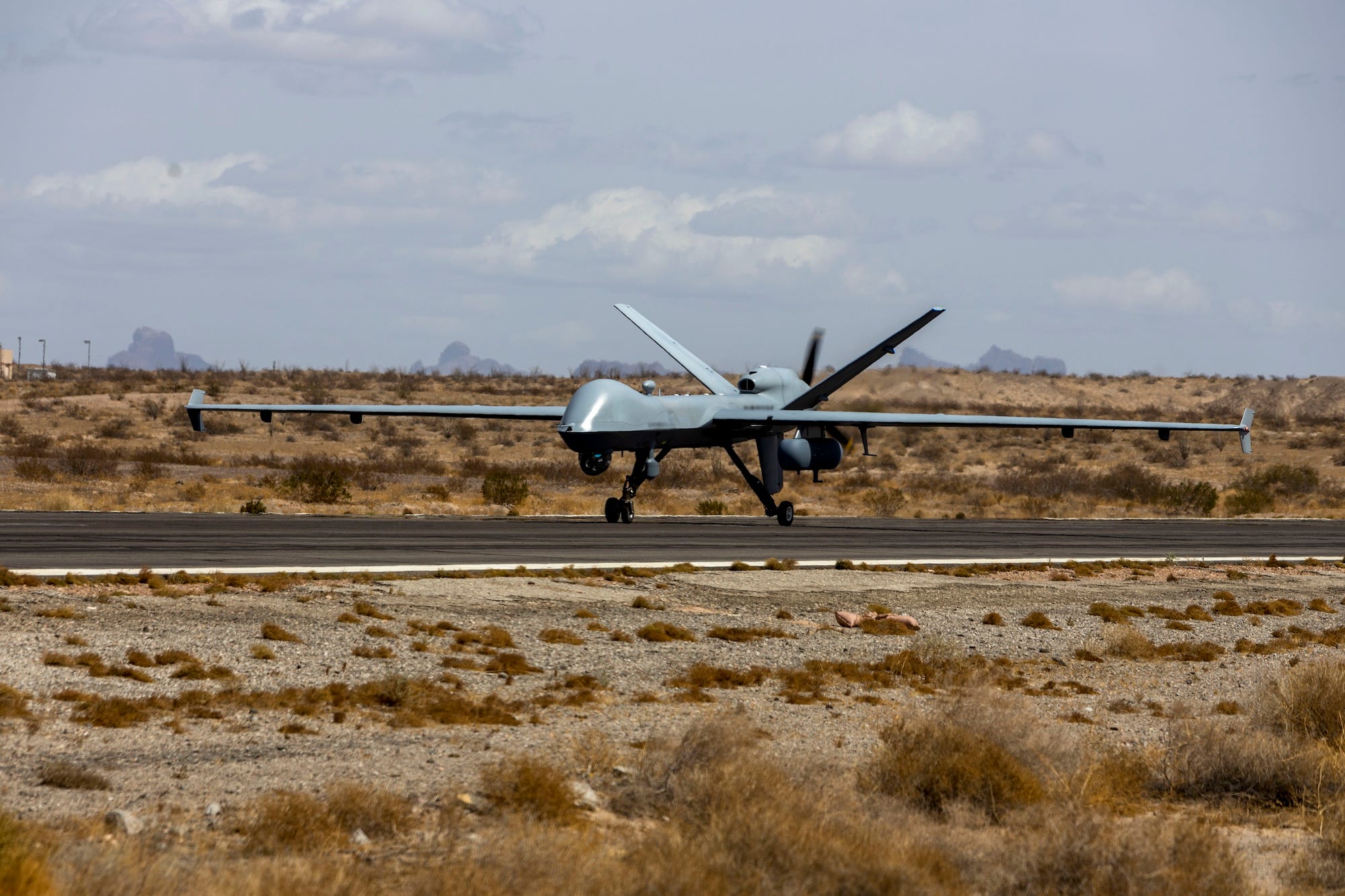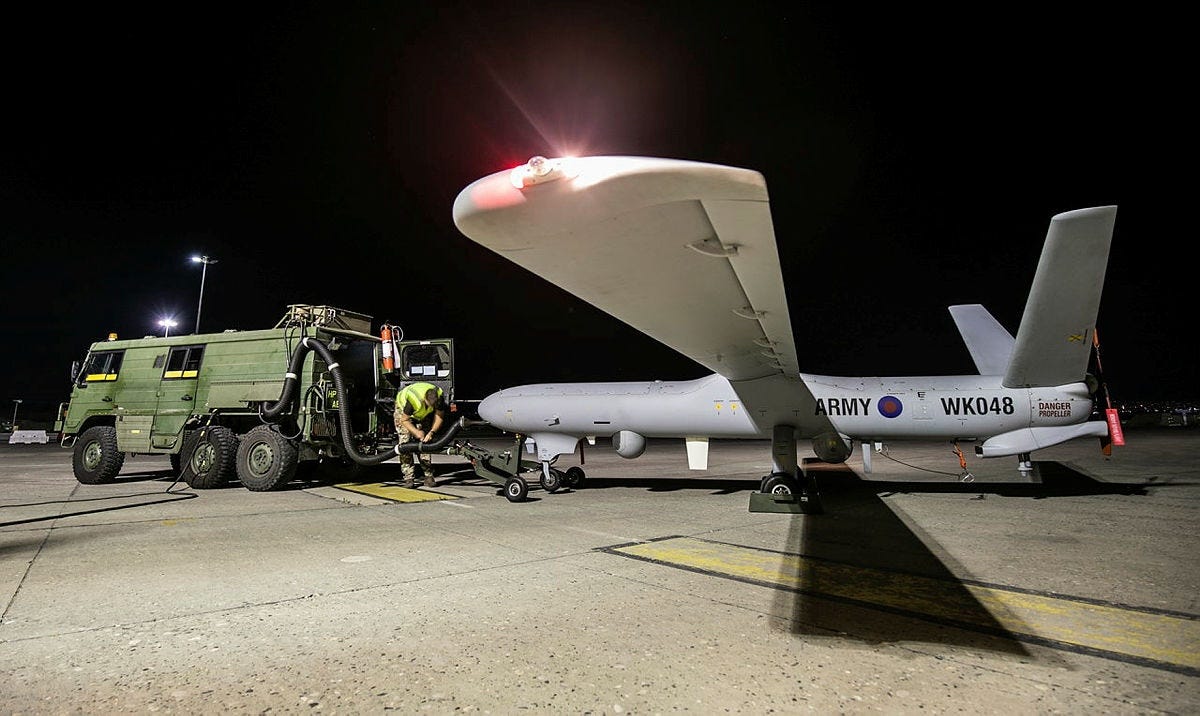
Cpl. Marc J. Imprevert/US Marine Corps
In the Global War on Terror, America’s MQ-9 Reaper was the most terrifying weapon. Armed with missiles and able to stay in the air for 24 hours, the Reaper — and its older cousin, the MQ-1 Predator — became the symbols of Drone Age remote-control warfare.
But the skies are not so Reaper-friendly anymore.
The Reaper built by General Atomics has a 66-foot wingspan is almost double that of small, crewed planes like the Cessna 172. Many of these big and expensive drones — the Reaper costs $30 million — have been shot down over Yemen, Lebanon, and Ukraine.
This has some experts questioning whether militaries like that of the UK should stop buying expensive Medium-Altitude Long Endurance (MALE) drones such as the Reaper. Better to purchase smaller, cheaper drones they can afford to lose, their thinking goes.
“MALE drones can provide persistent surveillance, including through clouds with Synthetic Aperture Radar (SAR), but only if they can survive,” wrote military researcher Robert Tollast in an essay for the Royal United Services Institute, a British think tank. “And as that survivability is now highly questionable, it seems that the UK must look for alternative approaches.”
At least 15 Reapers have been shot down by Houthi rebels over Yemen since October 2023, with seven destroyed in March and April 2025, estimated losses at or above $500 million. The threat to the Reapers would likely be much greater against a more advanced military, which fields larger and more accurate air defenses. Houthi air defenses are far from cutting edge: old Soviet-made SA-2 and SA-6 missiles date back to the 1960s, or are Iranian weapons based on those designs.
In the Ukraine war, Ukraine’s Turkish-made TB2 Bayraktar drones — armed with laser-guided anti-tank missiles — initially devastated Russian armored columns that invaded in February 2022. But dozens of TB2s were destroyed once Russian air defenses were deployed, and the Bayraktar has disappeared from Ukrainian skies. Meanwhile, Israel’s Hermes drones have fallen victim to Hezbollah anti-aircraft missiles.
This has left Britain in a quandary. The British Army’s MALE drone, the Watchkeeper, has proven a failure. Based on Israel’s Hermes 450, the Watchkeeper produced by Thales Group and Elbit Systems first flew in 2010, but wasn’t deployed until 2018. Delays, technical issues and several crashes spurred the retirement of the Watchkeeper fleet in March, less than seven years after it was fielded.

Cpl Matthews/UK MOD
“We are getting rid of Watchkeeper because that system has been in service since 2010 and, according to all the military chiefs, is out of date,” Lord Vernon Croaker, a senior official in the Ministry of Defense, told the House of Commons in November 2024.
With a range of almost 100 miles, the Watchkeeper could peer deep into enemy areas and locate supply depots, airbases and other targets for long-range artillery, missiles and aircraft. Thus the British Army is now embarked on Project Corvus, which calls for a long-endurance surveillance drone that can stay airborne for 24 hours and fly deep penetration missions.
But this may only result in another MALE drone too expensive to buy in quantity, and too vulnerable to be expendable. These same issues threaten the Reaper ($30 million) and the Bayraktar TB-2 ($5 million). “Assessments in Ukraine would suggest that the point at which a UAV becomes attritable is a unit price below $200,000 for ISR [surveillance missions],” Tollast wrote.
This creates a cost-benefit dilemma. Hordes of cheap, expendable first-person view (FPV) drones have become the dominant weapon in the Ukraine war, paralyzing bold battlefield maneuvers and practically driving armored vehicles off the battlefield. These are mass-produced commercial drones that can be rigged for military missions at a total cost of hundreds of dollars. Most of these have limited payload capacity, altitude and a range of only around 10 miles.
On the other end of the spectrum is the airliner-sized RQ-4 Global Hawk, a high-altitude $200 million drone that is being retired from the US military. A Global Hawk was destroyed by an Iranian anti-aircraft missile in 2019.
In the middle are the drones like the Reaper, which can carry a 2-ton payload of missiles and sensors, has a range of 1,200 miles, and can fly at 50,000 feet. The Reapers were essential aircraft in the wars in Iraq and Afghanistan as they could stay in the air hunting for targets far longer than a crewed aircraft, and be placed in more dangerous airspace because there was no risk to a human flier. For example, from September 2007 to July 2008, MQ-9 flew 480 sorties totaling more than 3,800 hours in Afghanistan.
In many ways, these UAVs resemble the earliest drones, which were just modified versions of manned aircraft. For example, World War II F6F Hellcat fighters converted into remote-controlled machines for target practice. The AQM-34L Firebee that flew reconnaissance missions over Vietnam was 29 feet long, not much shorter than an MQ-9.
They face a glaring problem: more adversaries are armed with air defense missiles capable of knocking out aircraft-sized drones. Drones like the MQ-9 were not designed to fly in areas covered by an enemy’s surface-to-air missiles. A Bayraktar’s cruise speed is only 80 miles per hour, while even a relatively speedy Reaper has a cruise speed of around 200 miles per hour. Thus even a militant group like the Houthis can down an MQ-9 with an old Soviet SA-6 surface-to-air missile.
This puts drones at a fork in the road — go low-cost and large volume or even higher-cost with fewer aircraft but more capability. America’s Reaper replacement may do the latter: a more sophisticated — and expensive — drone that includes stealth capabilities to evade radar; radar remains the primary means for air defenses to detect targets. For Britain, with its far smaller defense budget of roughly $70 billion, an improved MALE drone isn’t viable. Tollast sees several non-drone options, including Low Earth Orbit satellites, high-altitude balloons, and tethered aerostats (such as blimps), which avoid the vulnerability of medium-altitude drones.
Yet satellites and balloons may not be in position when you need them, and aerostats can’t be dispatched quickly into remote areas. Unless a technological breakthrough enables small UAVs to enjoy the capabilities of their larger brethren, the inability of large drones to function reduces the huge advantage of sensing the battlefield that the US and Western militaries have enjoyed.
Michael Peck is a defense writer whose work has appeared in Forbes, Defense News, Foreign Policy magazine, and other publications. He holds an MA in political science from Rutgers Univ. Follow him on Twitter and LinkedIn.
The post The reign of the Reaper drone may be coming to an end appeared first on Business Insider.




